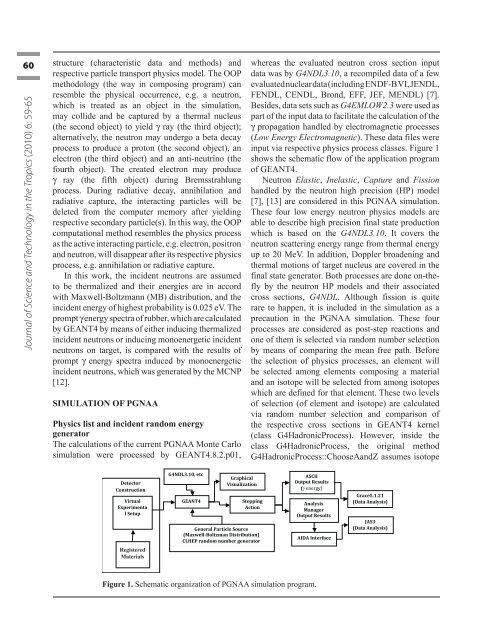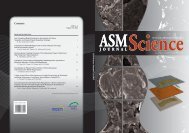Download - Akademi Sains Malaysia
Download - Akademi Sains Malaysia
Download - Akademi Sains Malaysia
You also want an ePaper? Increase the reach of your titles
YUMPU automatically turns print PDFs into web optimized ePapers that Google loves.
60<br />
Journal of Science and Technology in the Tropics (2010) 6: 59-65<br />
structure (characteristic data and methods) and<br />
respective particle transport physics model. The OOP<br />
methodology (the way in composing program) can<br />
resemble the physical occurrence, e.g. a neutron,<br />
which is treated as an object in the simulation,<br />
may collide and be captured by a thermal nucleus<br />
(the second object) to yield γ ray (the third object);<br />
alternatively, the neutron may undergo a beta decay<br />
process to produce a proton (the second object), an<br />
electron (the third object) and an anti-neutrino (the<br />
fourth object). The created electron may produce<br />
γ ray (the fifth object) during Bremsstrahlung<br />
process. During radiative decay, annihilation and<br />
radiative capture, the interacting particles will be<br />
deleted from the computer memory after yielding<br />
respective secondary particle(s). In this way, the OOP<br />
computational method resembles the physics process<br />
as the active interacting particle, e.g. electron, positron<br />
and neutron, will disappear after its respective physics<br />
process, e.g. annihilation or radiative capture.<br />
In this work, the incident neutrons are assumed<br />
to be thermalized and their energies are in accord<br />
with Maxwell-Boltzmann (MB) distribution, and the<br />
incident energy of highest probability is 0.025 eV. The<br />
prompt γ energy spectra of rubber, which are calculated<br />
by GEANT4 by means of either inducing thermalized<br />
incident neutrons or inducing monoenergetic incident<br />
neutrons on target, is compared with the results of<br />
prompt γ energy spectra induced by monoenergetic<br />
incident neutrons, which was generated by the MCNP<br />
[12].<br />
SIMULATION OF PGNAA<br />
Physics list and incident random energy<br />
generator<br />
The calculations of the current PGNAA Monte Carlo<br />
simulation were processed by GEANT4.8.2.p01,<br />
Detector <br />
Construction <br />
Virtual <br />
Experimenta<br />
l Setup <br />
Registere<br />
Registered<br />
d <br />
Materials Materials <br />
G4NDL3.10, etc <br />
GEANT4 <br />
Graphical <br />
Visualization <br />
General Particle Source <br />
(MaxwellBoltzman Distribution) <br />
CLHEP random number generator <br />
Figure 1. Schematic organization of PGNAA simulation program.<br />
whereas the evaluated neutron cross section input<br />
data was by G4NDL3.10, a recompiled data of a few<br />
evaluated nuclear data (including ENDF-B VI, JENDL,<br />
FENDL, CENDL, Brond, EFF, JEF, MENDL) [7].<br />
Besides, data sets such as G4EMLOW2.3 were used as<br />
part of the input data to facilitate the calculation of the<br />
γ propagation handled by electromagnetic processes<br />
(Low Energy Electromagnetic). These data files were<br />
input via respective physics process classes. Figure 1<br />
shows the schematic flow of the application program<br />
of GEANT4.<br />
Neutron Elastic, Inelastic, Capture and Fission<br />
handled by the neutron high precision (HP) model<br />
[7], [13] are considered in this PGNAA simulation.<br />
These four low energy neutron physics models are<br />
able to describe high precision final state production<br />
which is based on the G4NDL3.10. It covers the<br />
neutron scattering energy range from thermal energy<br />
up to 20 MeV. In addition, Doppler broadening and<br />
thermal motions of target nucleus are covered in the<br />
final state generator. Both processes are done on-thefly<br />
by the neutron HP models and their associated<br />
cross sections, G4NDL. Although fission is quite<br />
rare to happen, it is included in the simulation as a<br />
precaution in the PGNAA simulation. These four<br />
processes are considered as post-step reactions and<br />
one of them is selected via random number selection<br />
by means of comparing the mean free path. Before<br />
the selection of physics processes, an element will<br />
be selected among elements composing a material<br />
and an isotope will be selected from among isotopes<br />
which are defined for that element. These two levels<br />
of selection (of element and isotope) are calculated<br />
via random number selection and comparison of<br />
the respective cross sections in GEANT4 kernel<br />
(class G4HadronicProcess). However, inside the<br />
class G4HadronicProcess, the original method<br />
G4HadronicProcess::ChooseAandZ assumes isotope<br />
Stepping <br />
Action <br />
ASCII <br />
Output Results <br />
(γ energy) <br />
Analysis <br />
Manager <br />
Output Results <br />
(γ energy) <br />
AIDA Interface <br />
<br />
Grace5.1.21 <br />
(Data Analysis) <br />
JAS3 <br />
(Data Analysis) <br />
Jostt vol 6.indd 60 7/22/10 10:09:53 PM

















